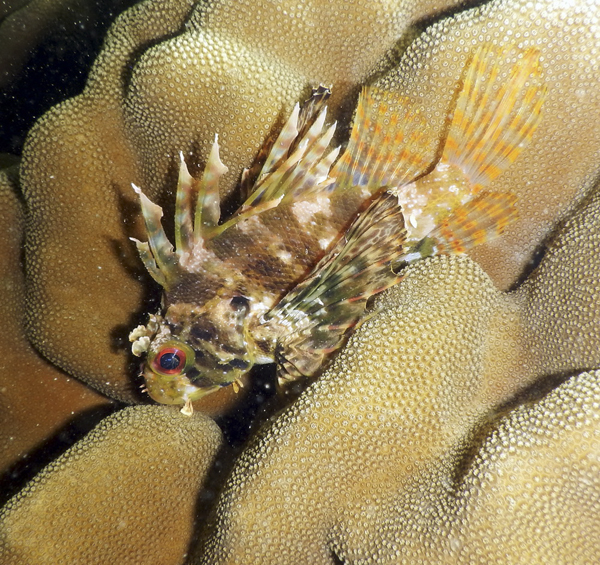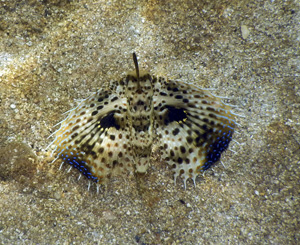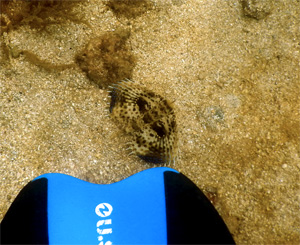Published in the Ocean Watch column, Honolulu Star-Advertiser © Susan Scott
July 7, 2014
Two friends, former Hawaii residents, visited from Oakland last week, and we hit all of Oahu’s hot spots. Hot spots for fish watching, that is. Wild night life for us was watching TV until 10.
We snorkeled, among other places, at Shark’s Cove, Hanauma Bay, Kahe Point (nicknamed Electric Point after the power plant there) and Lanikai’s outer reef.
 An inch-long Hawaiian green lion fish.
An inch-long Hawaiian green lion fish.
©2014 Susan Scott
The first two sites are marine sanctuaries, and the last two are not, but you don’t need signs to know that. All you have to do is get in the water. In the protected areas the fish barely move to get out of snorkelers’ paths, and some species, such as nenue (chubs), swim so close it’s hard to get a focused photo.
This kind of tameness is a learned behavior called habituation. After repeated encounters with humans where nothing bad happened, animals stop fearing us.
In areas where netting and spearing are allowed, however, the fish view us as predators, dashing for cover at the approach of a swimmer.
Even with this marked contrast in fish behavior between protected and unprotected spots, my friends and I noticed that all four places had one notable thing in common: Hawaii’s warm summer waters and long daylight hours have stimulated a baby boom.
So many colorful little fish swarmed the coral heads, it felt like we were swimming in a bowl of goldfish crackers. Butterflyfish, damselfish, tangs, cardinal fish, trumpet fish, moray eels, goatfish — all in perfect miniature. I even saw an inch-long Hawaiian green lion fish, a tiny flying gurnard and a baby scorpionfish wolf down a baby surgeonfish.

 A tiny flying gurnard & with fin for size reference.
A tiny flying gurnard & with fin for size reference.
© Susan Scott
In one place, white specks dotted the water like dust motes in the afternoon sun. When I reached out to touch one, it darted away. The specks were fish or invertebrates in larval form.
Exceptions are common, but in general tropical reef fish go through three stages before adulthood: embryo, larva and juvenile.
Embryos depend entirely on the mother for nourishment, either in the yolk of the egg she produced or by a placentalike connection. When an embryo breaks free it’s called a larva (plural larvae), defined as a creature able to catch its own food.
And I mean creature. Most fish larvae have huge eyes, and each species has its own special structures (whips, spikes, feathery filaments) for respiration and locomotion. Larvae, therefore, don’t usually resemble the fish they will become, but look more like space aliens in goggles.
Larvae dart around to eat and avoid being eaten, but they can’t swim against currents. This inability to get around on their own is the definition of plankton, Greek for “wanderer.”
Both fish eggs and larvae are a huge part of the ocean’s plankton. In the next transformation, larvae become juveniles. With some exceptions, such as the parrotfish and wrasses that change color dramatically as they grow, juvenile reef fish look like minuscule adults.
The lucky ones we saw had made it to shelter on the reef. The lucky of those will make it to adulthood to start the cycle all over again.
These hot summer months are a great time to check out Hawaii’s underwater nurseries. It’s as much fun as finding Nemo.